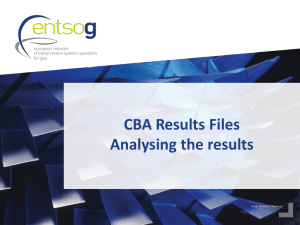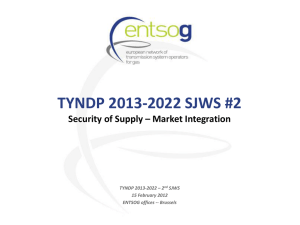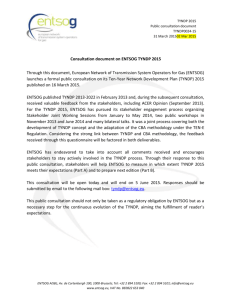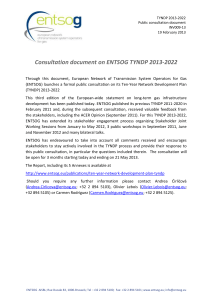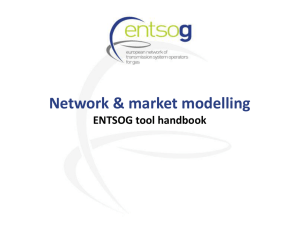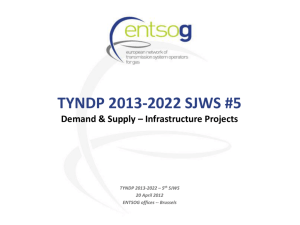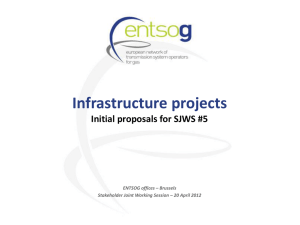Stakeholders' Input
advertisement
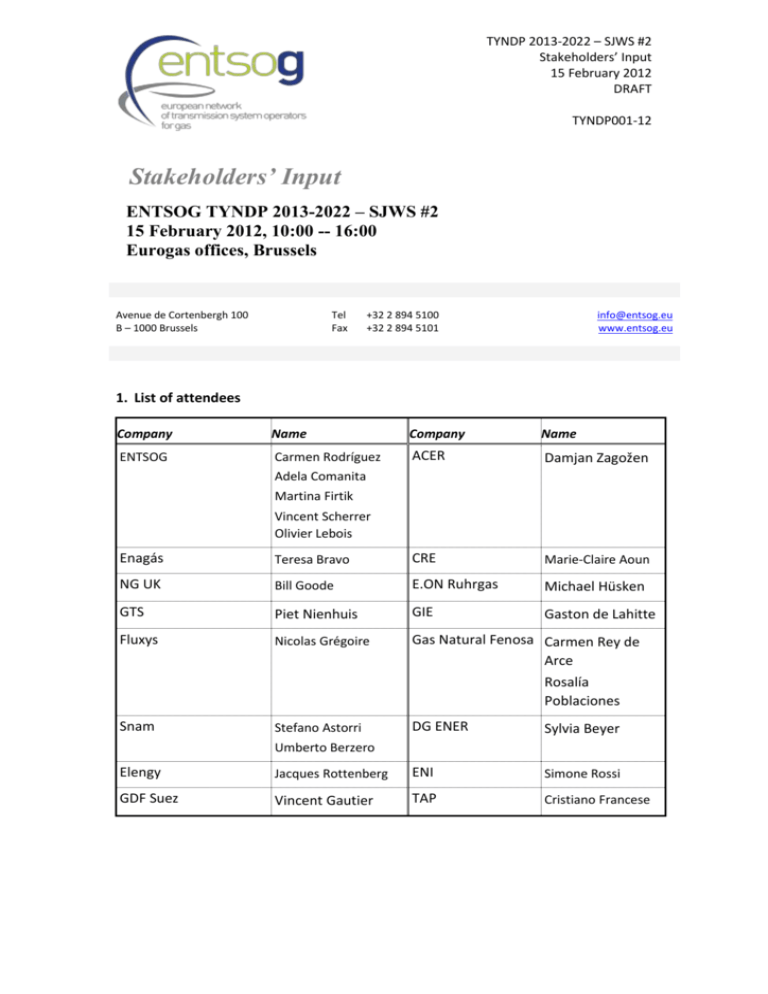
TYNDP 2013-2022 – SJWS #2 Stakeholders’ Input 15 February 2012 DRAFT TYNDP001-12 Stakeholders’ Input ENTSOG TYNDP 2013-2022 – SJWS #2 15 February 2012, 10:00 -- 16:00 Eurogas offices, Brussels Avenue de Cortenbergh 100 B – 1000 Brussels Tel Fax +32 2 894 5100 +32 2 894 5101 info@entsog.eu www.entsog.eu 1. List of attendees Company Name Company Name ENTSOG Carmen Rodríguez ACER Damjan Zagožen Adela Comanita Martina Firtik Vincent Scherrer Olivier Lebois Enagás Teresa Bravo CRE Marie-Claire Aoun NG UK Bill Goode E.ON Ruhrgas Michael Hüsken GTS Piet Nienhuis GIE Gaston de Lahitte Fluxys Nicolas Grégoire Gas Natural Fenosa Carmen Rey de Arce Rosalía Poblaciones Snam Stefano Astorri DG ENER Sylvia Beyer Umberto Berzero Elengy Jacques Rottenberg ENI Simone Rossi GDF Suez Vincent Gautier TAP Cristiano Francese The 2st SJWS focused on the explanation and discussion regarding the methodology of the TYNDP 2011-2020 in terms of modelling, security of supply and market integration. Furthermore, suggestions for the upcoming TYNDP 2013-2022 were presented and discussed during the meeting. Pros and Cons of the following suggestions were openly discussed; any conclusions and recommendations concerning the TYNDP 2013-2022 development are subject to further discussion in SJWS. 2. Security of Supply resilience assessment Infrastructure load factor within business as usual conditions are ambiguous information to assess the use of a project as most of the time the flexibility of the model is such that plenty of alternative paths . Thus, the load factors for scenarios with limited constraints should not be published in the TYNDP. When an investment gap has been identified, it should be noticed if capacity on both side of the border is or is not the same. Considering the higher capacity in mismatched interconnections as a potential value of capacity to be developed was suggested. However, this cannot necessarily be understood as the cheapest solution In any case TSOs concerned should justify why those differences are not alleviated. TYNDP should identify congestion at infrastructure level TYNDP should identify countries that cannot satisfy demand in disruption cases and therefore problematic situations; however, solutions are primarily developed by the market on the project level Physical reverse flow is not necessarily always the most costefficient solution to solve problematic situations identified in disruption cases When an infrastructure is still not operational, the load factor in Annex E should not be mentioned A common load factor for infrastructure (existing, FID and non-FID) related to the same supply source should be used in Annex E, with projects in Annex A also clearly listed in Annex E -2- A better consistency between Annex A and Annex E in terms of classification of projects should be ensured Specific pipes (partially exempted from TPA and not integrated in existing E/E zones) should be identified in the topology of the modelling tool, distinguishing between regulated pipelines as part of an entry-exit market area and exempted pipelines with a multi-national character. SOS scenarios should be updated to support implementation of Reg 994/2010 and assessment of infrastructure bottlenecks following gas supply disruptions It could be useful to include a graphical representation of the RSI indicator (mentioned in the Target Model): % demand non-covered by the mayor gas supply source per country and DR Index (see South GRIP 2011-2020): level of diversification of routes into an area. 3. Market Integration assesment In the predominant supply scenarios, the results may seem distorted by an unchanging level of national production. To avoid this effect, supply share ranges could be based on the system needs minus national production or completing the market integration graphs including the reason why the predominant supply is not able to spread at the maximum range across a certain country (lack of crossborder interconnection capacity, competence with national production…). In the predominant supply scenarios, more accurate (narrow) supply share ranges would help the understanding The number of sources a country has access may be completed or replaced by the maximum share of each source. The definition of Market integration should be expanded. Market integration is not only related to access to supply but also integration with adjacent systems, measuring the influence of a system in the adjacent ones, avoiding isolated systems and developing long gas corridors from all directions. Regarding Market Integration the following concepts are important: enough crossborder interconnection capacity between countries, reversible gas flows, high number of different supplies, and price convergence. The -3- analysis of the supply spread may be renamed as “Source accessibility for end consumers”. Market diversification of supply sources should be one of the elements to integrate in the concept of market integration TYNDP should help to assess the end of gas islands and the completion of the missing links of the European energy corridors. It should assess if the infrastructure allows peripheral countries/regions to maximize their exports towards the continental market by using the remaining flexibility. Moreover, TYNDP should assess to what extent peripheral regions can cover their peak demand through imports from the continental market. TYNDP could assess market integration based on the marginal supply and transmission cost as within EWI study released in 2010 A HHI index as mentioned in the early stage of Target Model could be considered A HHI index based on capacity should be used for comparison purpose between 2 scenarios and not from on system with the others. See South GRIP 2011-20 (Diversification of gas routes, pages 56-58). Also useful for SoS scenarios. Good functioning of the market is the first element of market integration before infrastructures Data availability is poor in particular in those regions, where market integration is low; this makes the assessment by means of correlation of past hub prices more difficult and will probably miss the target. Assessment should not be based only on static indicator such as N-1 and HHI which only focus on capacity and not gas and capacity together TYNDP should help to defined the physical requirements of a wellfunctioning market A different method is needed for the analysis of the LNG integration, to avoid LNG integration resolved with new LNG Terminals instead of cross-border interconnection capacity (real spread). Additional LNG flexibility deriving from the reloading development was suggested to be considered as an alternative to pipe solution. -4- To this point, it should be stressed that LNG reloading is a subsidiary service that few LNG terminals are offering. For diverse reasons such as its use is not as immediate as pipeline capacity, as it depends on meteorological conditions and economic interests, or because the destination cannot be guaranteed in the long term, reloading is very far from being comparable to a pipeline solution. Modelling should be based on pure decoupled entry/exit zones, requiring to split some systems into several nodes. The impact of new infrastructure on capacity serving as back-up to power generation from renewable energy sources should be assessed. Additional criteria regarding to the contribution of projects to support market coupling/gas hub development should be included in order to evaluate PCIs (impact in liquidity, price transparency, price correlation, etc) -5-
